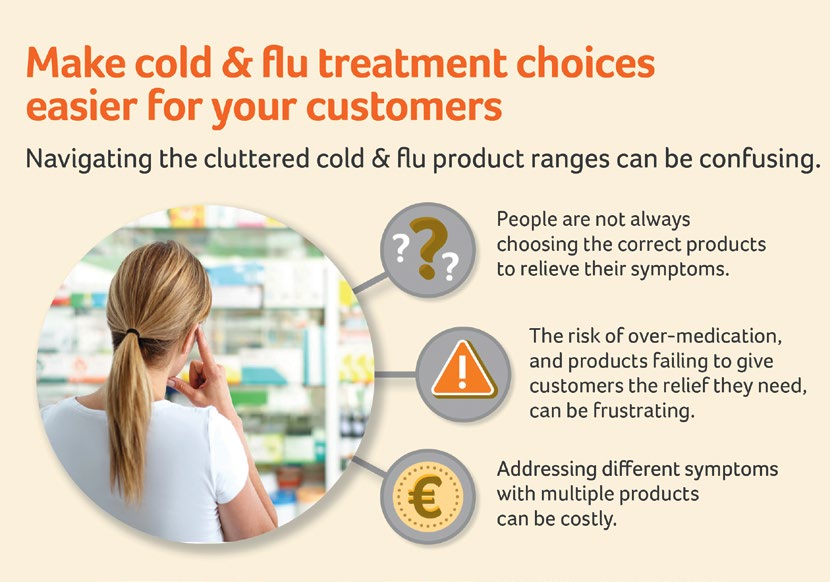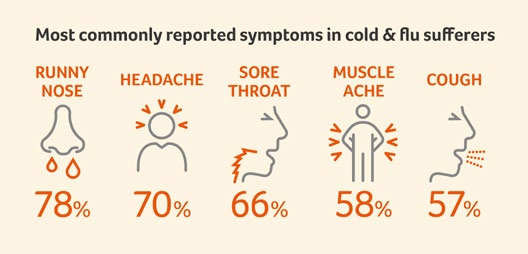Home » Managing cold and flu symptoms
Every year during the cold and flu season, most patients consider their community pharmacy as the first port of call to help manage symptoms. Consumer research shows that an average of 80% of the population are likely to visit a pharmacist with cold and flu symptoms. In this article, community pharmacist Amy Oates provides an overview of the consultation pathway, treatments and potential need for referral, when dealing with cold and fluymptoms.

The majority of patients will look to treat symptoms of cold and flu within three days of onset, and many will expect an all-in-one product to relieve all symptoms. Every interaction with a patient is an opportunity to provide the most appropriate advice and treatment recommendations. However, engaging in a consultation with patients about their cold or flu symptoms can sometimes be difficult. Many just simply ask for a specific product and are not looking for additional advice from the pharmacy team. This is where our pharmacy teams can focus on ensuring that all patients are getting the best possible care, and most appropriate treatment.

There are several stages in the consultation pathway, and the whole pharmacy team should use the same system to promote consistent care. The first stage during any consultation begins when the patient presents to the counter and ends with the patient satisfied with their recommended treatment:
Patients wishing to purchase specific products can be less willing to engage in a consultation. This is where our pharmacy teams need to focus to ensure that the product is suitable
Patients who present wishing to purchase specific products can be less willing to engage in a consultation. This is where our pharmacy teams need to focus to ensure that the product is suitable. Rather than going straight to select the product for the patient we can direct the conversation back through the consultation pathway. Start by asking if the product is for them or someone else. By engaging in a conversation with the patient it will initiate the consultation journey and work through the stages outlined. If a patient has pre-selected a cold and flu product to purchase, discuss their symptoms alongside the appropriateness of the product selected. Alternative management options should be presented with reasons why these options may be suitable.


Many patients can find it difficult to find the appropriate treatment, with so many options available. Patients often choose incorrect treatments to relieve their symptoms. Patients are at risk of using too many products to treat their symptoms and can often be over-medicating and overusing some ingredients. This is where our pharmacy teams can ensure the most effective treatment for cold and flu symptoms. Pharmacological management consists primarily of symptomatic relief for the presenting symptoms. Following the consultation pathway, the choice of product should be based on patient preference, presenting symptoms, and clinical considerations. Pharmacists and their team need to ensure that patients are aware of the active ingredients in combination products and that the correct product is selected to manage symptoms.



Special consideration should be given to certain groups where their management may require additional care, intervention and attention. For instance, older people, those who are pregnant or immunocompromised.
A community pharmacist can easily diagnose a common cold. If a more serious infection is suspected, or involvement of the lower airways, then patients should be referred to a medical practitioner for further assessment. When assessing patients’ presenting symptoms, pharmacists can identify red-flag symptoms which warrant direct referral to a GP:
Some red-flag signs and symptoms accompanying cough /sore throat can include but is not limited to:
Further information can be found in the International Pharmaceutical Federation (FIP)’s handbook for pharmacists, Cold, Flu and sinusitis: Managing symptoms and supporting self-care (available at fip.org/file/5089).
Pharmacists have a unique opportunity to make a differential diagnosis, educate patients on the management of these common conditions, and provide appropriate therapy and advice. Ensuring pharmacy teams engage in effective consultations when patients present with cold and flu symptoms will ensure the highest standard of care for all patients. There is also an important role in antimicrobial stewardship and supporting self-care.
Pharmacists have a huge role in antimicrobial stewardship (AMS). A lot of patients can expect an antibiotic for treatment of their cold and flu symptoms. AMS not only looks at challenging inappropriate prescribing of antimicrobials but also plays a role in the prevention of infection and promoting self-care for cold and flu, right from the initial contact with the patient. Pharmacists are ideally placed to educate patients about the indications for use of antibiotics and the importance of avoiding their misuse and overuse. Patients should be educated on the difference between bacterial and viral infections as well as the reasons why antibiotics are not effective against viruses, which are the primary cause of the common cold and flu. Pharmacy teams can help reshape the patients perceptive of managing cold and flu symptoms. Pharmacists must encourage their teams to reinforce public health messaging around prevention of infection and self-care for cold and flu, and they must strongly discourage patients from automatically seeking antibiotics. This message needs to begin at the start of the patient journey — at first presentation, when initiating the consultation. This can be achieved through an effective consultation, with appropriate treatment recommendations resulting in successful symptom relief.
According to the World Health Organisation, self-care is defined as; “the ability of individuals, families and communities to promote health, prevent disease, maintain health, and to cope with illness and disability with or without the support of a healthcare provider”. Self-care is a broad area that looks at many factors such as a patient lifestyle, their nutrition, general and personal hygiene and self-medication. Pharmacists can empower patients to help them make healthy lifestyle choices, recommend appropriate non-prescription medicines, and educate them on when they should visit a GP.
Flu vaccination is one of the most effective methods of preventing flu illness. Vaccination has been associated with a reduced risk of flu infection and transmission, hospitalisation, and risk of flu-related death in at-risk patients. As pharmacists, we can help to ensure our patients are offered a flu vaccine each year, especially those in at-risk groups. By providing a flu vaccination service in our pharmacies we are reinforcing our roles as first-line, easily accessible primary healthcare professionals.
References available on request.
Amy Oates

MPSI
Highlighted Articles